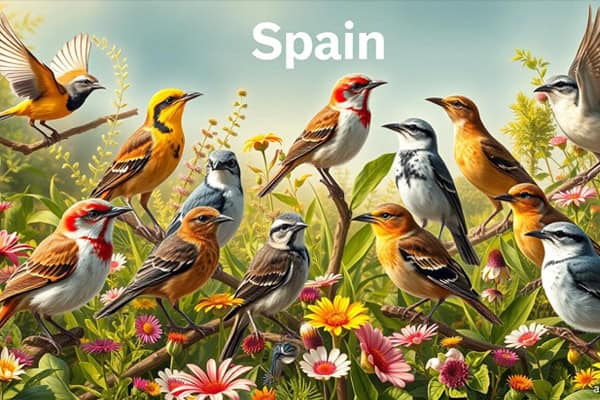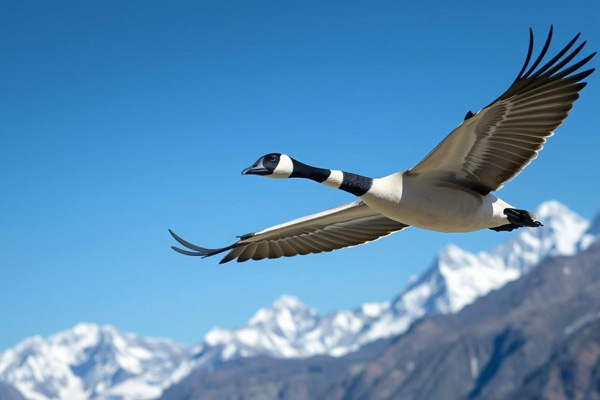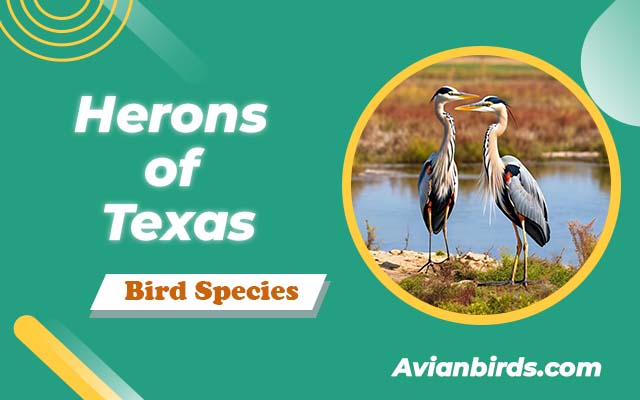Birds in Spain (12 Common Species With Pictures)
Did you know Spain is home to over 600 birds of species? It’s one of the top countries for birds in Europe. You can find these birds in many places, from busy city parks to quiet wetlands. Let’s dive into the world of birds in Spain and learn about 12 common species that many people love.
We’ll show you these amazing birds through beautiful pictures and tell you about where they live and what they do. This article is for anyone interested in birds or nature. It will give you a closer look at the common bird species in Spain.
12 Common Species of Birds in Spain
Exploring Spain’s bird life reveals many fascinating species. We focus on 12 common birds, highlighting their looks, behaviors, and where they live. This guide is great for identifying and appreciating these birds.
| Bird Species | Identifying Features | Preferred Habitat |
|---|---|---|
| Common Chaffinch | Vibrant plumage, pink chest | Woodlands, gardens |
| Common Wood Pigeon | Sleek body, soft cooing | Urban areas, rural settings |
| Dunnock | Brown, streaked feathers | Hedges, shrublands |
| Common Blackbird | Glossy black feathers, yellow eyes | Parks, gardens |
| Eurasian Blackcap | Distinctive crown, beautiful song | Dense shrubbery, woodlands |
| Bullfinch (Eurasian) | Pinkish-red belly, black head | Gardens, woodlands |
| Eurasian Collared Dove | Soft cooing, distinct collar | Urban areas, parks |
| Eurasian Jay | Bright blue wing patch | Forests, woodlands |
| Grey Heron | Tall stature, sharp beak | Near water bodies |
| Common Kestrel | Hovering flight | Open fields, roadside |
| European Robin | Bright red breast | Gardens, parklands |
| Eurasian Hoopoe | Unique feather crown | Open fields, forests |
Overview of Bird Diversity in Spain
Spain is a hotspot for bird lovers, with a wide variety of bird species. By 2022, we counted 664 different bird species in Spain. This makes it a top spot for those who enjoy birds and nature.
Number of Recorded Species
Spain is home to many bird species, from common to rare ones. You can find them in cities and remote areas alike. This shows how different places support different birds, thanks to Spain’s varied landscapes and weather.
Endemic and Migratory Birds
Spain has its own special birds, like the Bolle’s pigeon, found only in the Canary Islands. It’s crucial to protect their homes. Also, many birds migrate through Spain, making it a key stop for them. These birds change the look of the country, adding to its bird diversity.
Common Habitats for Birds in Spain
Spain is home to a wide range of bird habitats. Each one is vital for the survival of different bird species. Let’s look at the main habitats: forests, parks, and coastal areas. Each is filled with various bird species.
Forests
Forests in Spain are key for birds. They offer places to nest and find food. Here, you can see birds like the Great Spotted Woodpecker and the Eurasian Jay.
The forests are rich in plants, making them perfect for these birds. They provide protection and plenty of food.
Parks and Urban Areas
Urban parks are important but often overlooked. They draw in many bird species, such as the European Robin and the Common Blackbird. These birds enjoy the trees, shrubs, and open spaces in cities.
This helps them live in busy places and adds to the local wildlife.
Wetlands and Coastal Regions
Wetlands and coastal areas are vital for coastal birds. They are key stops for migratory birds, offering food and places to nest. Birds like the Grey Heron and the Common Kestrel live here.
1. Common Chaffinch
- Scientific Name: Fringilla coelebs
- Size: 14–16 cm (5.5–6.3 in)
- Weight: 18–25 g (0.63–0.88 oz)
- Lifespan: 2–5 years (up to 10 years in the wild)
- Diet: Seeds, buds, and insects.
Common Chaffinches stand out with their bright plumage, especially the males’ pink chests. They live in various places, like woods and gardens, where they look for seeds and bugs.

2. Common Wood Pigeon
- Scientific Name: Columba palumbus
- Size: 38–44 cm (15–17 in)
- Weight: 240–600 g (8.5–21.2 oz)
- Lifespan: 3–5 years (up to 15 years in the wild)
- Diet: Seeds, fruits, and leaves.
The Common Wood Pigeon looks sleek, often seen in trees or flying over open areas. Their soft calls are common in both the city and the countryside.

3. Dunnock
- Scientific Name: Prunella modularis
- Size: 12–14 cm (4.7–5.5 in)
- Weight: 18–30 g (0.63–1.06 oz)
- Lifespan: 2–3 years (up to 7 years in the wild)
- Diet: Insects, worms, seeds, and berries.
Dunnocks, or hedge sparrows, are small and blend into hedges and shrubs. Their brown feathers help them hide from predators.

4. Common Blackbird
- Scientific Name: Turdus merula
- Size: 24–25 cm (9.4–9.8 in)
- Weight: 80–130 g (2.8–4.6 oz)
- Lifespan: 2–5 years (up to 20 years in the wild)
- Diet: Insects, fruits, and seeds.
Common Blackbirds are known for their beautiful songs. They have shiny black feathers and bright orange-yellow eyes. They like places with lots of plants and are often seen in parks and gardens.
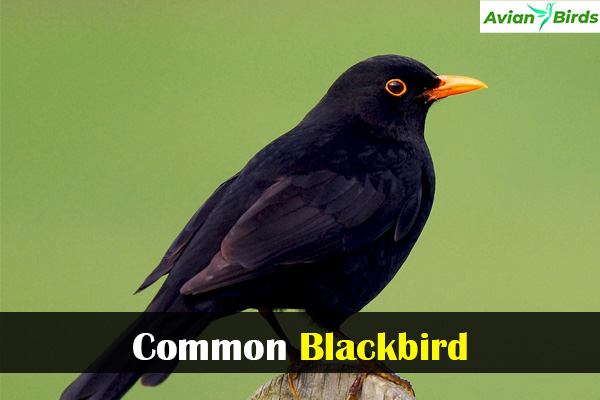
5. Eurasian Blackcap
- Scientific Name: Sylvia atricapilla
- Size: 12.5–14 cm (4.9–5.5 in)
- Weight: 14–22 g (0.49–0.78 oz)
- Lifespan: 2–5 years (up to 10 years in the wild)
- Diet: Insects, fruits, and berries.
The Eurasian Blackcap has a special cap-like crown and loves dense shrubs and woods. It’s famous for its lovely singing during the breeding season.
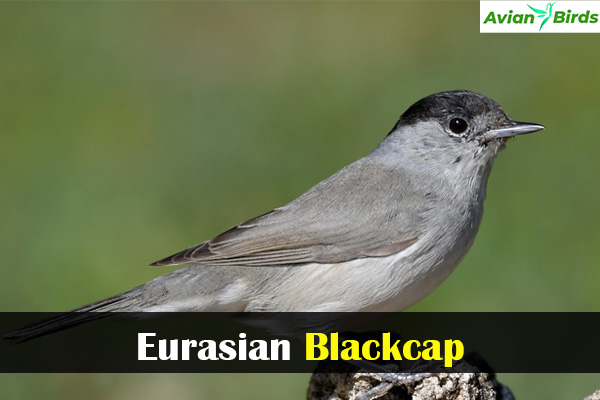
6. Bullfinch (Eurasian)
- Scientific Name: Pyrrhula pyrrhula
- Size: 14–16 cm (5.5–6.3 in)
- Weight: 18–30 g (0.63–1.06 oz)
- Lifespan: 2–5 years (up to 10 years in the wild)
- Diet: Seeds, buds, fruits, and berries.
The Eurasian Bullfinch has a striking pinkish-red belly and black head. These birds are often in gardens and woods, eating seeds and buds.
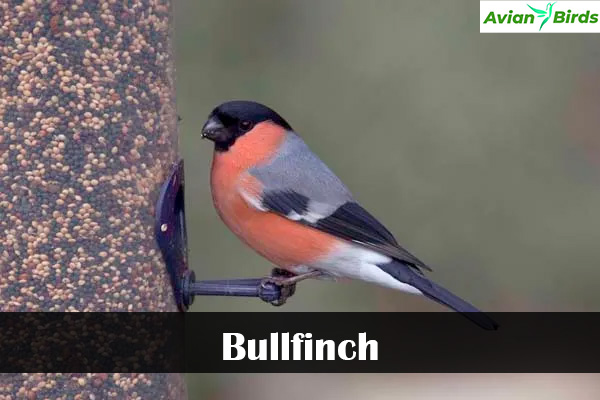
7. Eurasian Collared Dove
- Scientific Name: Streptopelia decaocto
- Size: 31–34 cm (12–13 in)
- Weight: 120–250 g (4.2–8.8 oz)
- Lifespan: 4–19 years
- Diet: Seeds, grains, and fruits.
Eurasian Collared Doves are medium-sized birds known for their soft cooing and distinct neck collar. They live in cities and are seen in parks and gardens.
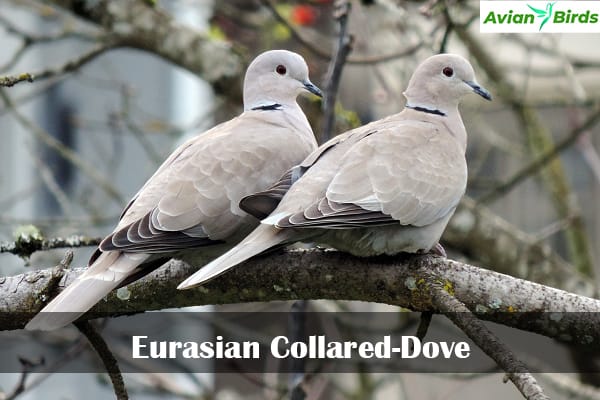
8. Eurasian Jay
- Scientific Name: Garrulus glandarius
- Size: 34–35 cm (13–14 in)
- Weight: 120–190 g (4.2–6.7 oz)
- Lifespan: 3–5 years (up to 15 years in the wild)
- Diet: Nuts, seeds, acorns, insects, and fruits.
The Eurasian Jay is vibrant and has a blue wing patch. It’s playful and lives in forests and woods, looking for acorns and nuts.
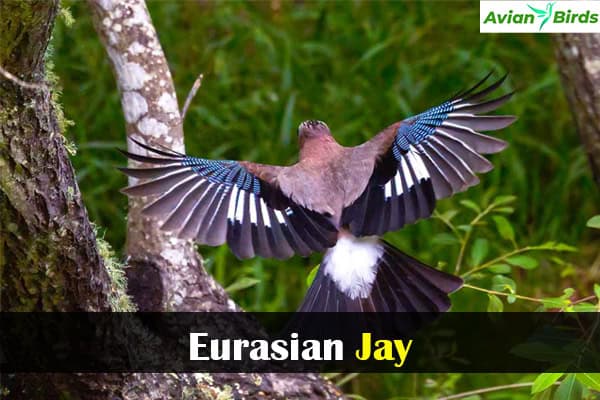
9. Grey Heron
- Scientific Name: Ardea cinerea
- Size: 88–98 cm (34–39 in)
- Weight: 1–2 kg (2.2–4.4 lb)
- Lifespan: 15–25 years
- Diet: Fish, amphibians, small mammals, and invertebrates.
Grey Herons are tall birds found near water. They have long legs and a sharp beak, perfect for hunting fish in lakes and rivers.

10. Common Kestrel
- Scientific Name: Falco tinnunculus
- Size: 32–36 cm (12.6–14.2 in)
- Weight: 150–300 g (5.3–10.6 oz)
- Lifespan: 5–10 years
- Diet: Small mammals, birds, and insects
The Common Kestrel is easy to spot in flight. It hovers and preys on small mammals and insects. You can see them on wires or in open fields.
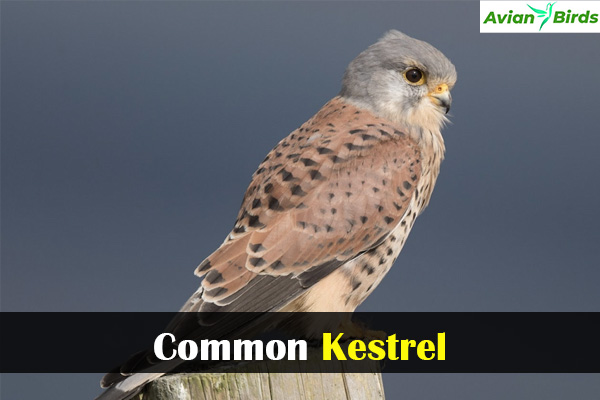
11. European Robin
- Scientific Name: Erithacus rubecula
- Size: 12.5–14.5 cm (4.9–5.7 in)
- Weight: 12–22 g (0.42–0.78 oz)
- Lifespan: 1–2 years (up to 13 years in the wild)
- Diet: Insects, worms, fruits, and seeds.
The European Robin is a favorite in Spain, known for its cheerful song and bright red breast. These birds are often in gardens and parks across the country.

12. Eurasian Hoopoe
- Scientific Name: Upupa epops
- Size: 24–32 cm (9.4–12.6 in)
- Weight: 50–100 g (1.8–3.5 oz)
- Lifespan: 3–10 years
- Diet: Insects, larvae, and seeds.
The Eurasian Hoopoe is known for its unique crown of feathers and bright colors. It’s found in open fields, forests, and parks, with a distinct call.
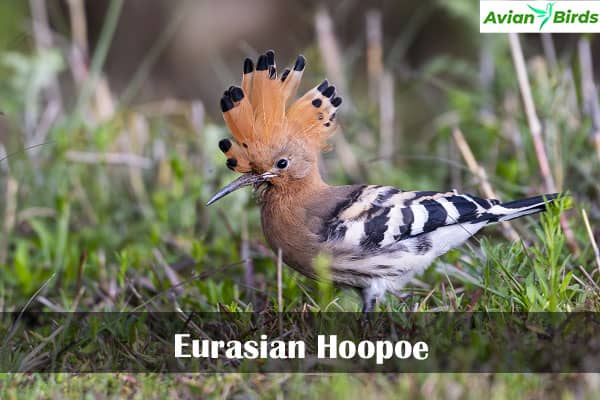
Identifying Features and Behavior
Knowing how to spot birds in Spain is easier with knowledge of their looks and actions. This helps bird watchers identify the many species found in the region. Let’s look at some common birds and their unique traits and behaviors.
Physical Characteristics of Common Species
Looking at birds closely can give us clues about who they are. The Common Blackbird stands out with its bright yellow eye ring and all-black look. On the other hand, the Eurasian Jay has blue patches on its wings, making it stand out in the woods.
Noticing these details helps us better identify birds and enjoy watching them.
Feeding Habits and Nesting
Each bird has its own way of eating, showing what it likes to eat. The Common Kestrel is a great hunter, hovering in the air before diving to catch its food. The Eurasian Blackcap eats fruits and insects, changing its diet with the seasons.
When it comes to nesting, some birds, like the Eurasian Collared Dove, choose hidden spots in trees. Watching birds during nesting season can give us a peek into their lives.
Best Locations for Bird Watching in Spain
We’re excited to share the top bird watching spots in Spain. These places offer great chances to see many bird species. You’ll find everything from national parks to urban areas and coasts, each with its own special birds.
National Parks
Doñana National Park and Monfragüe National Park are top spots for bird lovers. Doñana is known for its wetlands, a key spot for migratory birds. Monfragüe, with its mountains, is perfect for seeing raptors and other birds.
Urban Bird Watching Spots
Cities like Barcelona and Madrid are becoming popular for bird watching. Places like Parque del Retiro in Barcelona let you see many bird species. These urban areas show us how much bird life is right in the city.
Coastal Areas for Migratory Birds
Spain’s coasts are key for many birds’ migrations. The Ebro Delta is a great place to see shorebirds. Watching these birds helps us learn about their lives and behaviors.
| Location Type | Notable Features | Common Species |
|---|---|---|
| National Parks | Wetlands, Mountains | Flamingos, Eagles |
| Urban Areas | Parks, Gardens | Robins, Sparrows |
| Coastal Regions | Beaches, Estuaries | Shorebirds, Gulls |
Birding Activities and Communities in Spain
Engaging in birding activities can deepen our appreciation for nature and local ecosystems. Spain offers a vibrant community and a variety of options for bird enthusiasts. From guided bird watching tours to festive gatherings, there are many ways to immerse ourselves in the avian world.
Bird Watching Tours
Bird watching tours in Spain are an excellent way for us to learn from experts. They share their knowledge about local bird species. These tours take us to prime locations where we can observe both rare and common birds in their natural habitats.
Many operators provide unique experiences, from half-day excursions to week-long adventures. These are tailored to beginner and seasoned bird watchers alike. Some popular regions for bird watching include:
- Doñana National Park
- Balearic Islands
- Pyrenees Mountains
Birding Events and Festivals
Celebrating the rich avian life in Spain, numerous birding festivals offer opportunities for us to connect with fellow enthusiasts. These events often feature guided walks, workshops, and talks by experts. They promote awareness about bird conservation and showcase the diversity of bird species.
| Festival Name | Location | Month | Description |
|---|---|---|---|
| Birdwatching Festival | Doñana | September | A 5-day event featuring guided tours and workshops |
| Avifauna Festival | Extremadura | May | Focuses on the migration of birds with expert-led tours |
| Nature Fest | Catalonia | April | Integrates birdwatching with other nature-related activities |
Participating in birding activities and attending local events not only enriches our knowledge but also fosters a sense of community dedicated to bird conservation in Spain.
Birds in Spain: Cultural Significance
Birds are very important in Spanish culture. They are found in many stories and traditions. These stories show the deep connection between birds and Spanish culture.
From stories of migration to the nightingale’s song, these tales help us understand the bond between birds and Spanish culture.
Folk Stories and Traditions
Birds play a big role in Spanish folklore. Many stories tell of birds as messengers of good luck, love, or guidance. For example, seeing a swallow means hope and spring is coming.
These stories are told at local festivals. They keep the heritage alive and bring people together.
Birds in Spanish Art and Literature
Birds appear in many forms of art, like paintings, sculptures, and ceramics. Famous artists like Pablo Picasso and Joan Miró used birds to show freedom and go beyond limits. Birds also appear in books, standing for love, loss, or happiness.
This shows how much people value birds in art and literature in Spain.
Check Our Previous Articles:
| Small Birds with Long Beaks |
| Birds That Lay Blue Eggs |
| Birds With Red Beaks |
| Birds in South Carolina |
| Green Birds in Sarasota Florida |
Conclusion
In Spain, the variety of birds is truly amazing. From the green national parks to the busy city parks, there’s always something to see. Whether it’s the Common Chaffinch’s song or the Eurasian Hoopoe’s bright look, watching these birds makes us appreciate nature more.
Our journey through Spain’s birds and their homes shows us the beauty of birdwatching. Joining local birding groups or exploring new places helps us learn more about these amazing birds. It also connects us closer to nature. Let’s celebrate the birds that make our lives richer and help protect Spain’s nature.
The beauty of Spain’s birds tells us how vital it is to protect nature. Every bird’s movement invites us to join in the story of nature. Let’s keep exploring, learning, and loving the world of birds around us.

